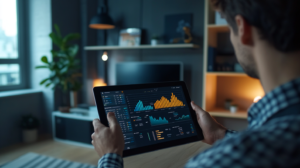Employee Activity Monitoring Tools For Remote Work

As the landscape of work continues to evolve, remote work has become a significant part of how businesses operate. However, managing a remote workforce presents unique challenges, particularly in monitoring employee activity and ensuring productivity. To address these challenges, many organizations are turning to employee activity monitoring tools for remote work. These tools provide valuable insights into how employees spend their time, enabling managers to make informed decisions and maintain high levels of efficiency.
Table of Contents
- The Importance of Monitoring Employee Activity in Remote Work
- Key Features of Employee Activity Monitoring Tools
- Benefits of Using Monitoring Tools for Remote Teams
- Addressing Privacy Concerns in Employee Monitoring
- Choosing the Right Monitoring Tools for Your Remote Workforce
- How Deskcove Enhances Employee Monitoring
- FAQ
The Importance of Monitoring Employee Activity in Remote Work
Employee activity monitoring tools have become essential for remote work environments. With the physical separation of teams, it’s challenging to gauge productivity and ensure that tasks are completed on time. Therefore, monitoring tools are crucial in helping managers maintain oversight and support their teams effectively.
Ensuring Accountability
One of the primary reasons for implementing monitoring tools is to ensure accountability. These tools allow managers to track how employees spend their work hours, ensuring that they are focused on their tasks. For instance, activity logging software can track the applications and websites employees use, providing a clear picture of their work habits.
Improving Productivity
Productivity tracking tools can highlight areas where employees may be struggling, enabling timely interventions. By identifying bottlenecks or distractions, these tools help optimize workflows and improve overall productivity. This is particularly important in remote work settings, where employees may face more distractions than in a traditional office environment.
Key Features of Employee Activity Monitoring Tools
When choosing monitoring tools for remote work, it’s essential to consider the key features that will benefit your organization. These features are designed to provide comprehensive insights into employee activity and help managers make informed decisions.
Time Tracking
Time tracking for remote teams is a fundamental feature of most monitoring tools. It allows managers to see how much time employees spend on specific tasks, ensuring that deadlines are met and projects stay on track. For instance, remote employee monitoring software often includes time logs that break down work hours by project or task.
Screen Monitoring
Screen monitoring tools provide real-time insights into what employees are doing on their computers. This feature is particularly useful for identifying productivity issues or ensuring that employees are adhering to company policies. Screen monitoring can also be used to review work progress, ensuring that employees are on the right track.

Benefits of Using Monitoring Tools for Remote Teams
There are several significant benefits to using employee activity monitoring tools, especially for remote teams. These benefits go beyond just tracking time and include enhancing collaboration, improving performance, and boosting overall efficiency.
Enhanced Collaboration
Monitoring tools often come with features that support collaboration, such as task tracking software. These tools allow teams to stay aligned on projects, even when working from different locations. As a result, remote work supervision becomes easier, and team members can communicate more effectively.
Performance Analytics
Employee performance analytics are another critical benefit of these tools. By analyzing data from monitoring software, managers can identify top performers, address areas of concern, and tailor support to individual needs. This data-driven approach leads to better management and more effective remote workforce management.
Addressing Privacy Concerns in Employee Monitoring
While employee monitoring tools offer many benefits, they also raise concerns about privacy. It’s important to address these concerns to maintain trust and ensure that monitoring practices are ethical and transparent.
Transparency and Communication
To mitigate privacy concerns, it’s essential to communicate openly with employees about what data is being collected and how it will be used. For example, employees should be informed about the use of screen monitoring tools and how this information will contribute to their performance evaluations.
Balancing Monitoring and Privacy
Finding the right balance between monitoring and privacy is key. Monitoring tools should be used to support employee productivity, not to micromanage. By focusing on transparency and using these tools responsibly, organizations can create a positive remote work environment where employees feel valued and respected.
Choosing the Right Monitoring Tools for Your Remote Workforce
With so many options available, selecting the right employee activity monitoring tools for your remote workforce can be challenging. However, by considering your organization’s specific needs, you can find tools that will enhance productivity and support your remote teams effectively.
Assessing Your Needs
The first step in choosing the right tools is to assess your organization’s needs. For instance, if your team works on complex projects, you may need robust task tracking software that can handle multiple tasks and deadlines. On the other hand, if your focus is on time management, a simple time tracking tool may suffice.
Considering Ease of Use
Ease of use is another critical factor when selecting monitoring tools. The best tools are those that integrate seamlessly into your existing workflows and require minimal training. For example, real-time activity monitoring tools should be intuitive, allowing both managers and employees to use them without difficulty.
How Deskcove Enhances Employee Monitoring
Deskcove offers a comprehensive suite of tools designed to support remote work by providing robust employee monitoring features. With Deskcove, managers can track time, monitor screen activity, and analyze performance data, all from a single platform. This integration makes it easier for organizations to manage their remote teams effectively, ensuring that projects stay on track and productivity remains high.
FAQ
What are the best employee activity monitoring tools for remote work?
The best tools depend on your organization’s needs, but popular options include Deskcove, Hubstaff, and Time Doctor. These tools offer comprehensive features like time tracking, screen monitoring, and performance analytics.
How can I ensure privacy while using monitoring tools?
To ensure privacy, communicate openly with employees about what data is being collected and how it will be used. Use monitoring tools responsibly and focus on supporting productivity rather than micromanaging.
Are monitoring tools necessary for remote work?
While not strictly necessary, monitoring tools can significantly enhance productivity and accountability in remote work environments. They provide valuable insights that help managers support their teams effectively.
